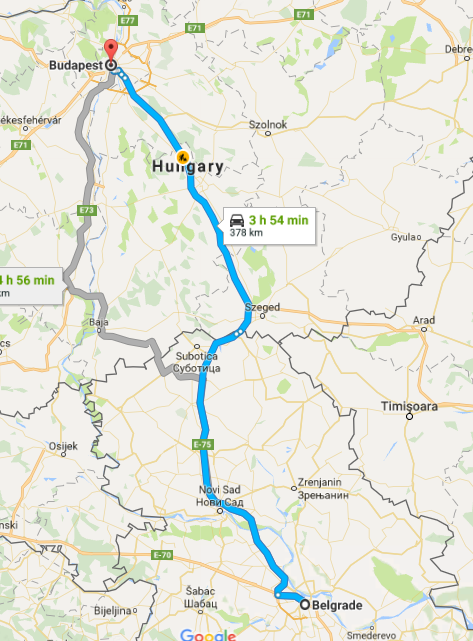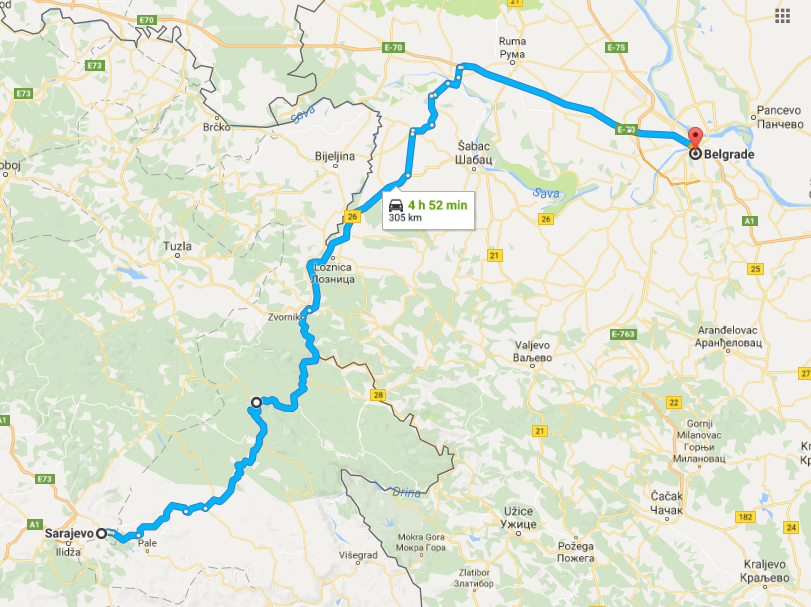Au réveil, la pauvre Audrey était plutôt mal en point. Son rhume s’était empiré et son genou lui faisait plus mal que la veille. En marchant tranquillement donc, nous nous sommes rendus à l’arrêt de l’autobus qui devait emmener sa mère à l’aéroport. Les au revoir et les accolades faits, nous avons de suite repris le chemin de l’appartement pour elle se recoucher et moi écrire. Se loger à Budapest n’est pas une mince affaire, on parle d’environ 30$ canadiens pour un lit en dortoir, donc cher quand on parle d’une moyenne à 20$ pour le reste de l’Europe. Là, nous avions réussi à dénicher un appartement complet à 40 euros en plein centre. Nous ne l’avions que pour deux jours, mais au moins c’était ça.
 Reposés, nous sommes sortis visiter en début d’après-midi. Après quelques centaines de mètres par contre, c’était clair qu’il fallait trouver des béquilles si nous voulions parcourir un peu de la ville. Selon moi, Audrey s’était déchiré un ménisque en faisant un faux mouvement et maintenant, chaque pas lui était douloureux. Histoire d’attirer les bonnes grâces du seigneur, nous nous sommes permis un arrêt dans la basilique de Saint-Istvan. Plutôt récente (début 20e), elle a son style intérieur bien a elle et rivalise en beauté et luxure avec Saint-Pierre de Rome. Ce moment pieux passé, nous nous sommes mis à la recherche de béquilles. Après avoir demandé à quelques pharmacies, nous sommes parvenus à dénicher le magasin dans les parages qui vendait du matériel prosthétique et acheter deux belles béquilles pour la très modique somme de 25$. À ce prix-là, quand bien même qu’elles ne serviraient que quelques jours, elle feront certainement un heureux en Asie Centrale.
Reposés, nous sommes sortis visiter en début d’après-midi. Après quelques centaines de mètres par contre, c’était clair qu’il fallait trouver des béquilles si nous voulions parcourir un peu de la ville. Selon moi, Audrey s’était déchiré un ménisque en faisant un faux mouvement et maintenant, chaque pas lui était douloureux. Histoire d’attirer les bonnes grâces du seigneur, nous nous sommes permis un arrêt dans la basilique de Saint-Istvan. Plutôt récente (début 20e), elle a son style intérieur bien a elle et rivalise en beauté et luxure avec Saint-Pierre de Rome. Ce moment pieux passé, nous nous sommes mis à la recherche de béquilles. Après avoir demandé à quelques pharmacies, nous sommes parvenus à dénicher le magasin dans les parages qui vendait du matériel prosthétique et acheter deux belles béquilles pour la très modique somme de 25$. À ce prix-là, quand bien même qu’elles ne serviraient que quelques jours, elle feront certainement un heureux en Asie Centrale.

 Béquilles en main, tranquillement nous avons pris le chemin du parlement hongrois. Audrey l’avait vu la veille en autobus touristique et m’avait conté sa splendeur et sa grandeur (le deuxième plus grand d’Europe après celui de Londres). À l’image du reste de la ville, le bâtiment était tout simplement époustouflant, rivalisant avec les palais de l’autre rive. Budapest est divisée en deux par le Danube. D’un côté Pest, anciennement plus ouvrière mais maintenant le coeur de la ville et l’autre côté Buda, la partie aristocrate bordée de palais et de résidences de luxe. Vous l’aurez compris, l’assemblage des deux donne Budapest. Pour traverser de l’autre côté, l’on prend évidemment un pont et fort heureusement, ces derniers sont bien desservis par les tramways, alors afin de nous rendre sur l’autre rive tout en ménageant nos articulations, nous avons emprunté l’un d’eux. De là, nous sommes grimpés en haute-ville pour admirer la vue et constater par nous même le passé aristocrate de Buda. Plus tard, Audrey ayant quand même parcouru ce jour-là quelques kilomètres à béquille, nous avons mis un terme prématuré à la journée en passant à l’épicerie chercher l’équivalent d’un apéro hongrois pour aller déguster le tout sur notre balcon.
Béquilles en main, tranquillement nous avons pris le chemin du parlement hongrois. Audrey l’avait vu la veille en autobus touristique et m’avait conté sa splendeur et sa grandeur (le deuxième plus grand d’Europe après celui de Londres). À l’image du reste de la ville, le bâtiment était tout simplement époustouflant, rivalisant avec les palais de l’autre rive. Budapest est divisée en deux par le Danube. D’un côté Pest, anciennement plus ouvrière mais maintenant le coeur de la ville et l’autre côté Buda, la partie aristocrate bordée de palais et de résidences de luxe. Vous l’aurez compris, l’assemblage des deux donne Budapest. Pour traverser de l’autre côté, l’on prend évidemment un pont et fort heureusement, ces derniers sont bien desservis par les tramways, alors afin de nous rendre sur l’autre rive tout en ménageant nos articulations, nous avons emprunté l’un d’eux. De là, nous sommes grimpés en haute-ville pour admirer la vue et constater par nous même le passé aristocrate de Buda. Plus tard, Audrey ayant quand même parcouru ce jour-là quelques kilomètres à béquille, nous avons mis un terme prématuré à la journée en passant à l’épicerie chercher l’équivalent d’un apéro hongrois pour aller déguster le tout sur notre balcon.



Au réveil, nous avons quitté les lieux pour déménager dans un autre appartement situé plus loin du centre-ville. Ce jour-là, il avait été décidé de donné du repos à Audrey, tant pour son rhume qui s’était empiré que pour son genou. Moi, j’allais parcourir la ville afin de trouver un objectif de remplacement pour la caméra ou un moyen de le réparer. Le premier magasin sur lequel nous sommes tombés en avait quelques-uns usagés en stock dont un 28-80 mm à 75$; notre objectif défectueux était un 17-85mm, donc plus performant de proche et un tout petit peu plus de loin. Considérant un prix à neuf de 600 euros et plus, celui que nous venions de trouver se montrait une option très intéressante. Une fois Audrey reconduite au nouvel appartement, j’ai continué mon enquête afin d’évaluer ce qui s’offrait. J’avais originalement réparé l’objectif défectueux avant de partir en voyage et je savais exactement ce qui ne fonctionnait pas dans ce dernier, soit l’obturateur, une pièce à 25$ sur eBay. En consultant un détaillant Canon, ceux-ci m’ont fait une estimation à 225$ pour la réparation. Évidemment, ils refusaient de me vendre la pièce dont j’avais besoin. Nous devions partir pour l’Ukraine le lendemain et 225$, c’était un peu trop cher payé pour quelque chose que je pouvais accomplir moi-même.

Heureusement, Budapest abonde en magasin de matériel photographique usagé, alors j’ai pu en parcourir quelques-uns afin de me faire une idée des prix. Ils vendaient tous des lentilles compatibles, mais beaucoup trop coûteuses, sauf une de 18-50mm à 100$… Malheureusement, elle était défectueuse quoi qu’opérable et le magasin n’a pas voulu me la céder dans l’état. Bredouille, je suis donc retourné au premier endroit pour acheter le 25-80mm. Pas aussi compétente que notre lentille originale, elle allait toute de même faire l’affaire. En dépannage, nous nous étions servis de nos cellulaires. Or, ils ont beaux être de nos jours être très performant au niveau photographique et permettre toutes sortes de fonctions intéressantes comme le panorama, ils demeurent très peu versatiles au niveau optique (la taille et le prix obligent) et dans des conditions de lumière sous-optimales. Enfin, nous allions de nouveau pouvoir prendre des photos intéressantes. Remarquez que cette panne m’aura permis d’apprivoiser la fonction panorama de mon cellulaire, alors ce dernier trouvera certainement son utilité de temps à autre. Content de ma trouvaille, je suis rentré à notre chambre pour aller la montrer à Audrey et sortir avec elle manger un peu.
 Durant l’après-midi à courir de gauche à droite, j’avais noté une diminution de mon état physique. Audrey m’avait de toute évidence contaminé avec son rhume. Profitant de l’énergie qu’il me restait, je l’ai laissée de nouveau pour aller visiter Budapest encore un peu et m’amuser avec le nouvel objectif. À mon retour par contre, j’étais définitivement malade: congestion, faiblesse et éternuements. Comme nous avions élu domicile dans un endroit plutôt festif de la ville, nous avons tenté la visite de ruin pubs, ce concept bien local d’investir une maison abandonnée pour en faire un bar illégal. Évidemment, si l’endroit se trouve maintenant sur le web dans les palmarès des places ou sortir dans la capitale et engage des gardes pour faire la sécurité pour contrôler la foule, on est rendus loin de l’idée originale. Nous nous sommes donc rabattus sur un biergarten. La raison aurait dicté une mise au lit de bonne heure, mais juste pour dire que nous sommes sortis au moins une fois à Budapest, nous avons fait l’effort … sans trop faire long feu.
Durant l’après-midi à courir de gauche à droite, j’avais noté une diminution de mon état physique. Audrey m’avait de toute évidence contaminé avec son rhume. Profitant de l’énergie qu’il me restait, je l’ai laissée de nouveau pour aller visiter Budapest encore un peu et m’amuser avec le nouvel objectif. À mon retour par contre, j’étais définitivement malade: congestion, faiblesse et éternuements. Comme nous avions élu domicile dans un endroit plutôt festif de la ville, nous avons tenté la visite de ruin pubs, ce concept bien local d’investir une maison abandonnée pour en faire un bar illégal. Évidemment, si l’endroit se trouve maintenant sur le web dans les palmarès des places ou sortir dans la capitale et engage des gardes pour faire la sécurité pour contrôler la foule, on est rendus loin de l’idée originale. Nous nous sommes donc rabattus sur un biergarten. La raison aurait dicté une mise au lit de bonne heure, mais juste pour dire que nous sommes sortis au moins une fois à Budapest, nous avons fait l’effort … sans trop faire long feu.
Budapest aura finalement été une pause technique, une sorte de courte convalescence. Nous aurions aimé voir plus de la ville, aller nous promener dans ses quartiers moins connus, visiter de ses musées, aller assister à un concert de musique classique… Bref, profiter davantage de tout ce que cette grande capitale avait à offrir. Pour diverses raisons, il n’en aura pas été ainsi et c’est un peu la conséquence d’avoir roulé le pied dans le fond ces dernières semaines. À tout le moins, nous l’avons visité un minimum.
Il semble y avoir deux types prédominants de touristes à Budapest, les groupes de jeunes sur la dérape (l’alcool n’est pas cher comparé au reste de l’Europe) et les couples bien nantis profitant d’un moment de luxe dans l’ancienne capitale impériale. N’étant plus l’un et pas encore l’autre, Budapest nous a paru quand même moins adaptée à notre réalité que d’autres endroits visités précédemment. Qu’importe, avec quatre genoux fonctionnels (plutôt que trois) et la pleine forme physique, nous y aurions certainement trouvés notre compte, mais j’image pouvoir plus en profiter dans un futur moins contraint par l’argent.
















